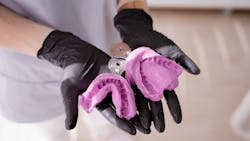Dental impression disinfection recommendations and best practices
Although digital impressions are the way of the future, many offices will continue to use impression material as part of their standard procedures. These impressions can transport potentially infectious material, including disease-causing microorganisms such as hepatitis B and C, tuberculosis, and HIV, out of the dental office and contaminate others in the community. In this instance, what happens in the dental office doesn’t always stay in the dental office.
Appropriate disinfection of dental impressions
In one study, some 67% of materials sent from dental offices to labs were found to be contaminated with Streptococci, Staphylococci, Candida species, MRSA, or P. aeruginosa.1 Studies have also shown that microbes of tuberculosis and hepatitis B can live for up to seven days or more at room temperature.2As well, the risk of hepatitis B infection among dental professionals is five to 10 times higher than that of the general population.3
It is the dental health-care providers' responsibility to ensure that all surfaces and devices, including dental impression materials, are adequately cleaned, disinfected, and sterilized to prevent cross-contamination and exposure to blood- and saliva-borne diseases. In most cases, impressions are left under running tap water to get rid of blood and saliva. Rinsing impressions under running water as soon as they’re removed from a patient's mouth was standard practice for sanitization up until 1991. Numerous studies since then have shown that such a technique can only eradicate 40% of bacteria, fungi, and viruses, meaning the risk of infection remains considerable.
This means that dental staff must use appropriate disinfection techniques to eliminate any potential dangers. The disinfection of dental impressions can be completed via various methods including chemical disinfection using either the immersion or spray method, autoclaving, microwaving, and UV radiation.
Also by Michelle Strange:
How digital treatment planning can increase case acceptance
Promoting infection control practices in your dental office
A note about IC protocols
It is unfortunate that infection control still frequently takes a back seat despite its importance, particularly when we are still experiencing a pandemic. This lack of gravity was brought to my attention at a dental convention as I spoke with several vendors selling impression material. When I asked their disinfection advice, I learned that none of them could provide an adequate response other than to say that we should follow the product's instructions for use (IFU).
While this is a valid point, as IFUs are meant to document how we should deal with reusable instruments, there was an unsettling lack of consideration regarding preventing infection control breaches or effort to ensure that dentists are not using the wrong chemicals or methods that could cause problems with dental impressions. Infection prevention is often put at the bottom of the priority list, and this was just one recent example of that thinking.
We are well aware of the significance of preventing cross-infection, yet impression disinfection is still mostly overlooked. The effectiveness, chemical stability, and efficacy of the disinfectant solution should all be considered when devising a dental impression disinfection strategy. The chosen method should not alter the dimensions and surface of the impression and subsequent cast either.
When it comes to removing pathogens from impression surfaces, chemical disinfection (either immersion or spraying) has been shown to be the most efficient way thus far. Immersion is the most reliable as the disinfectant solution can reach all corners and crevices of the impression. However, spraying is a preferred method for particular hydrophilic materials such as alginate, which can distort upon immersion.
Main methods of disinfection
Disinfection with immersions and sprays
The International Dental Federation (IDF), American Dental Association (ADA), Centers for Disease Control and Prevention (CDC), and British Dental Association (BDA) all recommend disinfection of impressions or impression materials to be carried out before sending impressions to the laboratory. They also state that dentists or dental assistants are solely responsible.4
The two most prevalent disinfection techniques are immersion and spraying, which employ chemicals such as alcohols, aldehydes, phenols, chlorine combinations, iodide combinations, and ammonium.
While simple water rinsing has no discernible impact on disinfection, spraying and submerging have nearly identical antimicrobial effects. Disinfection via immersion has been found to disinfect all surfaces and undercuts at once, while spraying has been found to be less comprehensive in terms of area coverage.
But unlike immersion, spraying can significantly reduce the amount of distortion of certain materials. For instance, when alginate, a commonly used impression material, is submerged in disinfectant solution, its hydrophilic properties cause it to absorb water, resulting in distortion—spraying and immersing both result in a loss of surface details of the same degree.
Microwave disinfection
Microwave disinfection is an effective and versatile approach that is fast, easy to use, economical, and easily performed by dentists, dental assistants, and technicians. This technique impairs cell membrane integrity and cell metabolism, leading to microbial death. Currently, this method is employed in the effective disinfection of dentures.5
UV light disinfection
Ultraviolet light is recommended as a suitable disinfection method for impressions as it doesn’t affect its dimensional stability.6 Time, intensity, humidity, and contact of UV from the microorganisms all impact disinfection efficacy. Since dental impressions have small crevices and numerous places where microorganisms can thrive, the UV light must be reflected in multiple directions for it to be effective. C. albicans colonies have been shown to dramatically reduce when exposed to UV light with a maximum death efficiency at 24 watts compared to direct-current low discharge. Higher wattage was shown to reduce colony count in an even shorter time.
Whichever disinfection method you choose, the effective removal of pathogens is of utmost importance in creating a clean and safe office for your staff and patients. Carrying out this additional step of infection control is necessary to preserve the safety, integrity, and quality of your dental office. Failing to do so may cause infection to spread, and that is something no one wants.
References
- Powell GL, Runnells RD, Saxon BA, Whisenant BK. The presence and identification of organisms transmitted to dental laboratories. J Prosthet Dent. 1990;64(2):235-237. doi:10.1016/0022-3913(90)90185-f
- Kramer A, Schwebke I, Kampf G. How long do nosocomial pathogens persist on inanimate surfaces? A systematic review. BMC Infect Dis. 2006;6:130. doi:10.1186/1471-2334-6-130
- Dahiya P, Kamal R, Sharma V, Kaur S. Hepatitis—prevention and management in dental practice. J Educ Health Promot. 2015;4:33. doi:10.4103/2277-9531.157188
- Mantena SR, Mohd I, Dev K P, et al. Disinfection of impression materials: a comprehensive review of disinfection methods. Int J Dent Mater. 2019;1(1). https://doi.org/10.37983/IJDM.2019.1102
- Klironomis T, Katsimpali A, Polyzois G. The effect of microwave disinfection on denture base polymers, liners and teeth: a basic overview. Acta Stomatol Croat. 2015;49(3):242-253. doi:10.15644/asc49/3/7
- Samra R, Bhide SV. Comparative evaluation of dimensional stability of impression materials from developing countries and developed countries after disinfection with different immersion disinfectant systems and ultraviolet chamber. Saudi Dent J. 2018;30(2):125-141. doi:10.1016/j.sdentj.2017.11.005
About the Author
Michelle Strange, MSDH, RDH
Michelle Strange, MSDH, RDH, has more than two decades of dental expertise, beginning as a dental assistant and completing a bachelor’s degree in health science from the Medical University of South Carolina and a master’s in dental hygiene education from the University of Bridgeport. She continues to invest in ongoing education, gaining certifications such as her Certificate in Dental Infection Prevention and Control. Her community and global endeavors demonstrate her passion for dentistry, from volunteer work to worldwide missions. She is the owner of Level Up Infection Prevention, MichelleStrangeRDH, a practicing dental hygienist, and was the cofounder and the fire and energy that made A Tale of Two Hygienists podcast.
Read Strange's DE Editorial Advisory Board profile here.
Updated October 10, 2022

